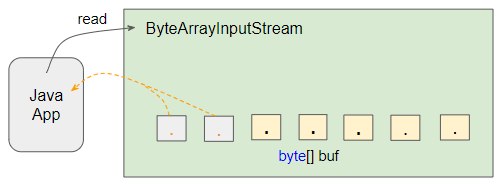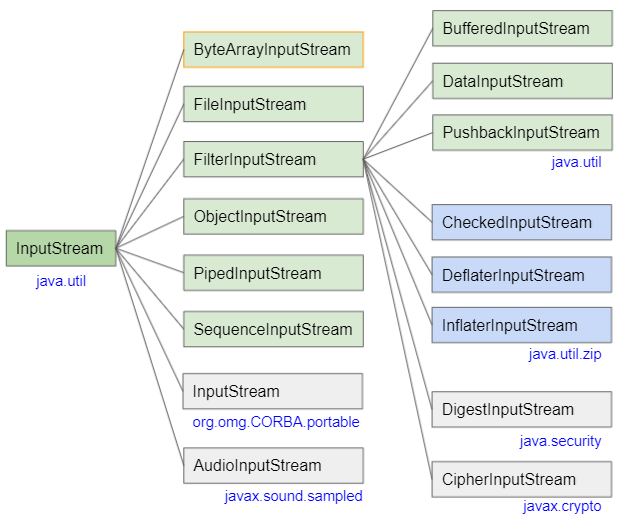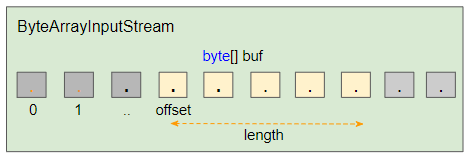Le Tutoriel de Java ByteArrayInputStream
1. ByteArrayInputStream
ByteArrayInputStream est une sous-classe d'InputStream. Comme son nom l'indique, ByteArrayInputStream est utilisé pour lire un tableau byte de manière d'un InputStream.


- InputStream
- SequenceInputStream
- ObjectInputStream
- DataInputStream
- FilterInputStream
- FileInputStream
- PipedInputStream
- BufferedInputStream
- PushbackInputStream
- CheckedInputStream
- CipherInputStream
- DeflaterInputStream
- DigestInputStream
- InflaterInputStream
- AudioInputStream
ByteArrayInputStream constructors
ByteArrayInputStream(byte[] buf)
ByteArrayInputStream(byte[] buf, int offset, int length)Le constructeur ByteArrayInputStream(byte[] buf) crée un objet ByteArrayInputStream pour lire un tableau byte.

Le constructeur ByteArrayInputStream(byte[] buf, int offset, int length) crée l'objet ByteArrayInputStream pour lire un tableau byte à partir de l'indice offset jusqu'à offset+length.

Toutes les méthodes de ByteArrayInputStream sont héritées d'InputStream.
Methods
int available()
void close()
void mark(int readAheadLimit)
boolean markSupported()
int read()
int read(byte[] b, int off, int len)
void reset()
long skip(long n)2. Examples
Par exemple: Lire un tableau byte de manière d'un InputStream:
ByteArrayInputStreamEx1.java
package org.o7planning.bytearrayinputstream.ex;
import java.io.ByteArrayInputStream;
import java.io.IOException;
public class ByteArrayInputStreamEx1 {
public static void main(String[] args) throws IOException {
byte[] byteArray = new byte[] {84, 104, 105, 115, 32, 105, 115, 32, 116, 101, 120, 116};
ByteArrayInputStream is = new ByteArrayInputStream(byteArray);
int b;
while((b = is.read()) != -1) {
// Convert byte to character.
char ch = (char) b;
System.out.println(b + " --> " + ch);
}
}
}Output:
84 --> T
104 --> h
105 --> i
115 --> s
32 -->
105 --> i
115 --> s
32 -->
116 --> t
101 --> e
120 --> x
116 --> tEn règle générale, toutes les méthodes de ByteArrayInputStream sont héritées d'InputStream. Vous pouvez trouver plus d'exemples sur la manière d'utilisation de ces méthodes dans l'article ci-dessous:
Tutoriels Java IO
- Le Tutoriel de Java CharArrayWriter
- Le Tutoriel de Java FilterReader
- Le Tutoriel de Java FilterWriter
- Le Tutoriel de Java PrintStream
- Le Tutoriel de Java BufferedReader
- Le Tutoriel de Java BufferedWriter
- Le Tutoriel de Java StringReader
- Le Tutoriel de Java StringWriter
- Le Tutoriel de Java PipedReader
- Le Tutoriel de Java LineNumberReader
- Le Tutoriel de Java PushbackReader
- Le Tutoriel de Java PrintWriter
- Tutoriel sur les flux binaires Java IO
- Le Tutoriel de Java IO Character Streams
- Le Tutoriel de Java BufferedOutputStream
- Le Tutoriel de Java ByteArrayOutputStream
- Le Tutoriel de Java DataOutputStream
- Le Tutoriel de Java PipedInputStream
- Le Tutoriel de Java OutputStream
- Le Tutoriel de Java ObjectOutputStream
- Le Tutoriel de Java PushbackInputStream
- Le Tutoriel de Java SequenceInputStream
- Le Tutoriel de Java BufferedInputStream
- Le Tutoriel de Java Reader
- Le Tutoriel de Java Writer
- Le Tutoriel de Java FileReader
- Le Tutoriel de Java FileWriter
- Le Tutoriel de Java CharArrayReader
- Le Tutoriel de Java ByteArrayInputStream
- Le Tutoriel de Java DataInputStream
- Le Tutoriel de Java ObjectInputStream
- Le Tutoriel de Java InputStreamReader
- Le Tutoriel de Java OutputStreamWriter
- Le Tutoriel de Java InputStream
- Le Tutoriel de Java FileInputStream
Show More